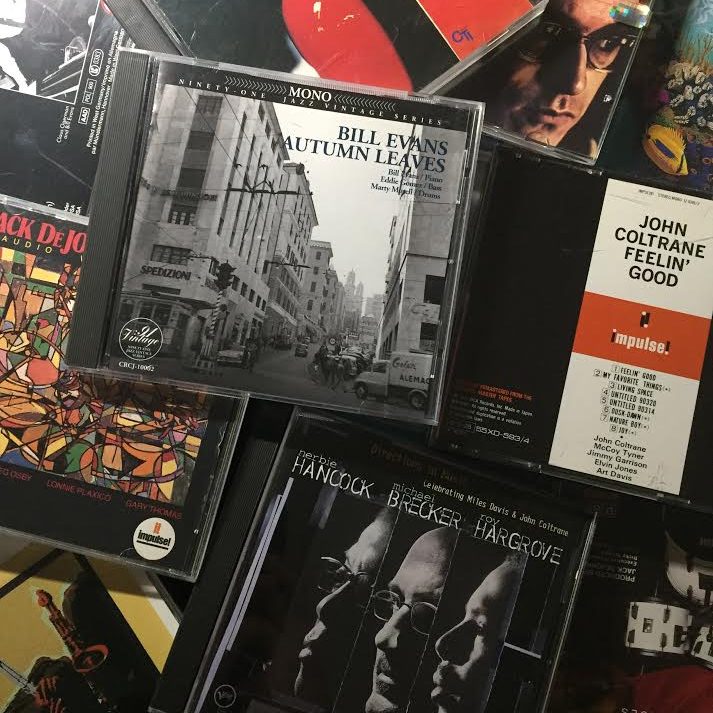Breaking the rules of music
“Didn’t want to play anything that sounded like something they’d heard before” – The band, Chavez, 1993
A selection of jazz music from my father’s CD collection.
After four years of exploring various music archives under the music genre “Math Rock”, I’ve learned that music is something you must cut up, chew, and digest to find out exactly what makes it delicious.
My first encounter with Math Rock music was when I listened to Literary Math, an album by Paranoid Void, an all-girls Japanese post-Math Rock band. From the moment I pressed play, I was amazed to find that one piece of music could be filled with a huge array of surprises; atypical rhythmic structures where the count changes every 10-15 seconds, conversations between different themes and variations that weave together perfectly despite sounding like two different stories, but also recognizable patterns that pop out throughout a piece, even leaving an earworm in your head. It’s almost like when you bite into popping shower ice cream for the first time and you get different pulsating tingling feelings inside your mouth. Each piece has its own relatable atmosphere: nostalgic, violent, calm, dark, or energetic. Compiled together in a 10-track album, they take the listener on an emotional rollercoaster.
So what exactly is Math Rock?
Math Rock is an experimental genre that plays with many elements such as distorted guitar riffs, angular melodies, and non-standard signatures in new ways. Artists of this genre are able to perform and replicate each piece with precision despite the complexity of the music.
According to Odd Times & Atmospheres, a community of musicians and experts in Math Rock, “Math Rock” was a term coined in the late 1990s: “([Math rock]) was invented by a friend of ours as a derogatory term. His whole joke was that he’d watch the song and not react at all, and then take out his calculator to figure out how good the song was. So he’d call it Math Rock, and it was a total diss, as it should be,” said Matt Sweeney, a lead guitarist of the band Chavez and Math Rock advocate. The term eventually came to describe anything dissonant in structure — hence its use in the name of albums like Literary Math whose tracks are full of atypical rhythms and distorted guitar riffs.
Anyone who has listened to enough Math Rock pieces will know that the genre encompasses a range of unique compositions that sound very different from one another. As I dug through the Math Rock songs on my Apple music library and my father’s CDs however, I was able to identify several fundamental components shared by all Math Rock music:
First, the syncopated, odd-time rhythms date back to the late 19th century when syncopated rhythm and polyrhythms were gaining popularity in the West. One of the most prominent genres at the time was jazz, influenced by the melodic stylings from classical music, combined with complex rhythms inspired by African music. Pieces like “Maple Leaf Rag” by Scott Joplin rose to fame and is now known as one of the most famous ragtime jazz compositions in history. As jazz music began to spread and change in the early 20th century, David Brubeck (active years: 1940-2012), a well-renowned jazz legend, brought odd-time into the world, and it erupted like a must-try trend in the music world.
The next element was the fusion of jazz and rock: One of the artists who helped blur the lines between jazz and rock was an artist known as Frank Zappa (1960-1970) who also introduced the anger influence to the jazz fusion genre which developed in his active years. It is a genre where jazz improvisation and harmony is fused with rock, funk, and blues. The jazz-fusion based album, Chunga’s Revenge (1970 release) contains “Twenty Small Cigars”, a track in which Frank Zappa uses patterns of syncopal triplets, jazzy piano, with a more funk-like keyboard melody played together with some rock guitar to create a dreamy, relaxed, and laid-back piece. Also, in his album Hot Rats (1970 release), you can find a clear focus on jazz-rock fusion in comparison to his other works. Some of the tracks tend to lean towards the rock genre, ornamented with heavier guitar riffs, while some tracks have the classic jazz piano moving casually over waves illustrated by cymbals and subtle but jazzy drumming.
It is said that much of the Math Rock genre was a product of the jazz and rock fusion, progressive rock specifically as well as the more experimental “post-progressive” rock. Progressive rock is a genre that combines various elements from various styles including classical music, folk, and of course, rock. Some famous bands that fall into the pool of the progressive rock genre include Minutemen, who released the album Punchline; Frank Zappa (both from the 70’s to late 80’s); late progressive rock bands such as King Crimson, Piglet, Covet, American Football, IQ; and artists such as David Bowie and Peter Hammill.
The development of progressive as well as punk rock helped add various characteristics to the Math Rock genre over time. An underrated band which helped contribute to the growth of these genres and tie them to Math Rock is King Crimson (1968-1974, 1981-1984, 1994-2004, 2007-2009). You may be familiar with their song “21st Century Schizoid Man” if you’re a fan of the rapper Kanye West, who extracted an excerpt from this King Crimson song to use in his single, “Power”. They stacked time signatures and experimented with metric modulations creating illusions of 4/4 pulse in pieces like “Discipline”: funk-like groove mixed with post-progressive punk rock. Punk rock developed in the late 1970s, as mainstream rock was being rejected and changed by bands in the US, UK, and Australia. In The Court Of The Crimson King was the first true progressive rock album. Songs like “The Court Of The Crimson King” and “Epitaph” are majestic, powerful and beautiful, while “21st Century Schizoid Man” is “brutal and jarring”—there’s still nothing else which sounds like it. I don’t think any symphonic rock album has reached these heights since.
As bands were feeding off other artists’ energy and ideas, and genres were proliferating at a fast rate, the technical proficiency required to perform such music was also increasing in difficulty.
An example of a band that was a part of this movement was the Mahavishnu Orchestra (1971-1976, 1984-1987)—a unique virtuosic quintet known to have added a rock dynamic to the rhythmic and harmonic invention of jazz.
Brewing together rock, jazz, and blues, members of the Mahavishnu Orchestra helped introduce blues into the equation which would later also add to the Math Rock genre. The guitarist, John McLaughlin, for example, brought a huge amount of ideas to the table. He grew up listening to jazz by Django Reinhardt and blues inspired by instruments other than the guitar such as the piano and French horn. As you can hear in the way McLaughlin plays, he drew inspiration from Jimi Hendrix’s tone on the guitar and uses harmonic distortions analogous to what John Coltrane, a jazz composer, did on the sax.
As I was researching these influences, I began to realize how these jazz-rock fusions came to be. Finding myself on a better track, I sought to find the other elements that I heard in my Math Rock playlist and found other ancestries to these other dimensions I hear in the music.
World music: Talking Heads (1975-1991) is a good example of one of the most celebrated 70’s/80’s bands that were extensive in their polyrhythmic worldbeat explorations. They were known to be pioneers to new wave music as they integrated elements of punk and post-punk rock, funk, world music with an “avant-garde sensibility”, and world beat. Interestingly, they are cited as an influence on the following artists: 1975, Kesha, St. Vincent, and Radiohead. Thus, there are times when you will hear, for example, African beats and melodic patterns appear in some Math Rock compositions.
Distortion and rhythmic complexion: “American Don” is an album by Don Caballero (1991-1995, 1977-2000, 2003-2009), consisting of a multitude of tracks devoted to noise, drone, discordance, and strangeness. Their music was a trigger in the early ’90s that initiated the big bang of the Math Rock universe. This ever-evolving uncategorizable proliferation of music was labeled as post-rock. However, when compared to other post-progressive/rock band music, it was clearly different: the music had a key distinction that made it more dissonant and structurally complex. In their music, outstanding guitar-tapping techniques were added to create passages that gave an exquisite flavor over the drones and the already multifarious sound that lay low in the music.
When artists mix and match genres, the resulting product often serves as an inspiration for another. If drawn out and mapped, the connections and influences between various artists look like a messy family tree, as many bands change their style in music, divorcing certain styles and remarrying others. With Math Rock, a finger cannot be placed on a single line, as it covers a broad range. Even among the few bands I mentioned, there are clear connections between the artists which as a collective ultimately birthed this extensive genre called Math Rock.
As you can see, the Math Rock genre was not derived from progressive rock alone. The genre was influenced from many angles by a diverse range of artists who contorted music in new ways which, as a result, brought sophistication to this genre.
Many people tend to listen to the same piece of music on repeat until they get tired of it. However, Math Rock music offers so many motifs in just one composition that it can entertain one’s ears each and every time it is played. I promise it’s something worth diving into as there are so many exciting things happening in each instrumental part. I assure you—your approach to listening to music will change.
If you’re completely unfamiliar with Math Rock, here are a few recommendations to start with:
“Karma no Inu” a track from the album Literary Math by Paranoid Void
Phantasia, an album by LITE
























































